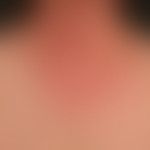Synonym(s)
DefinitionThis section has been translated automatically.
Allergic contact dermatitis (aerogenic allergic contact dermatitis) caused by airborne components of plants (mainly of the compositae family), as well as by various chemical products, medicines or perfumes.
EtiopathogenesisThis section has been translated automatically.
It has been proven that the skin (especially in cases of disorders of the skin barrier) can also serve as a gateway for the penetration of aerogenously transmitted allergens, including pollen. Already within minutes (30 min.) the skin is able to internalize appropriately applied pollen allergens.
The high sensitizing capacity of aerogenic contact allergens is mainly due to compounds of the sesquiterpenlactone substance class. They are found in high concentrations in the leaves and stems of many composites (e.g. feverfew, camomile blossom extract, fern extract, lesser celandine extract). They can also be found in some plants from other families, e.g. laurel (cross allergies).
There may also be phototoxic side effects (see phototoxicity below).
Airborne Contact Dermatitis has also been described with professionally relevant volatile chemical products such as rosin or epoxy resins. Fragrances are also of importance.
Less frequently, aerogenically transmitted poisonous hairs of the larvae of the oak processionary moth (see oak below; see caterpillar dermatitis below) are the cause (the microscopically small poisonous hairs are spread aerogenically up to 100 metres).
You might also be interested in
ClinicThis section has been translated automatically.
Subacute, extensive dermatitis in the area of the unclothed areas, especially on the face and décolleté.
In contrast to light-induced dermatoses, airborne contact dermatitis also causes dermitic changes on the upper eyelids (see eyelid eczema), retroauricularly and below the chin.
A seasonal dependence (May-September) of dermatitis is characteristic for the "plant-induced" forms and thus diagnostically pioneering.
If the seasonal dependence is missing, e.g. in case of occupational dependence (improvement during holidays) volatile chemical products (e.g. 2-aminothiophenol; epoxy resins) may be considered.
A dependence on the use of volatile cosmetics (e.g. perfumes) has to be checked.
Differential diagnosisThis section has been translated automatically.
TherapyThis section has been translated automatically.
Acute phase: Treatment of dermatitis according to its stage (see dermatitis, contact dermatitis, allergies).
Internal therapyThis section has been translated automatically.
Only in cases of weeping and extensive dermatitis is systemic therapy with glucocorticoids (50-100mg prednisolone i.v.) and antihistamines (e.g. dimetinden (Fenistil) 2 times/day 1 amp. i.v. or desloratadine (Aerius) 1-2 times/day 1 tbl. p.o. possibly necessary.
ProphylaxisThis section has been translated automatically.
Avoid the allergen if possible.
In case of a pollen-associated syndrome, it is recommended to apply creams or lotions containing lipid or dexpanthenol several times a day to the exposed skin areas, which should be moisturized in the meantime. This has been proven to prevent the direct pollen approach to the skin and thus the constant re-exposure to the allergen.
Case report(s)This section has been translated automatically.
Anamnesis: The 54-year-old florist noticed already during a "normal" working day in the midday hours an increasing itching and burning of the entire facial skin, the backs of the hands and wrists. In the evening hours, the entire facial skin was reddened, swollen and violently itchy, so that the emergency medical service had to be consulted.
Findings: The entire facial skin, including the eyelids, was reddened over a large area, diffusely swollen; in places, the facial skin was beginning to ooze (Fig.). The retroauricular region, the anterior and lateral parts of the neck, the nape of the neck and the backs of the hands were also affected by inflammation. No change was seen in the clothed forearms, torso, and scalp. The boundary zone to the clothing-covered skin areas were blurred. There was no feeling of illness, no fever, no painful lymphadenopathy.
Diagnosis: Acute dermatitis with v.a. airborne contact dermatitis.
Therapy and course: On an emergency basis, the patient was treated with a glucocorticoide externum as well as saline compresses renewed several times. She also received systemic prednisolone (dosage 100mg in tablets) and high doses of an antihistamine. Under this treatment, there was a marked improvement within 3 days (see Fig.2). Within the next 14 days, the skin condition normalized under gradual therapy with glucocorticoid ointments.
4 weeks after resolution of the "airborne contact dermatitis", evidence of (occupationally triggered) type IV sensitization) to a composite mix was obtained.
Summary: Special characteristics of composite allergens are their potential to induce airborne dermatitis, tendency to chronic courses, wide distribution in different plant families, to which contact must be avoided in case of existing sensitization. The different forms of exposure and manifestation of composite allergy imply a continuum from "minor" to "severe" effects of allergy in terms of occluded work opportunities.
Summary: (Airborne Contact Dermatitis):
Acute, subacute, or even chronic, patchy dermatitis in unclothed areas, especially the face.
In contrast to light-induced dermatoses, airborne contact dermatitis also causes dermatitic changes on the upper eyelids (see eyelid dermatitis), retroauricularly and below the chin.
A seasonal dependence (May-September) of the eczema is characteristic for the "plant-induced" "outdoor" forms and thus diagnostically groundbreaking. If the seasonal dependence is missing, volatile chemical products (e.g. 2-aminothiophenol; epoxy resins) come into question, e.g. in case of occupational dependence (improvement during vacation). Furthermore also volatile cosmetics (e.g. fragrances).
LiteratureThis section has been translated automatically.
- Bonomonte D et al (2002) Occupational airborne allergic contact dermatitis from 2-aminothiophenol. European J Dermatol 12: 592-593
- Custis NJ et al (2003) Quantitative measurement of airborne allergens from dust mites, dogs, and cats using an ion-charging device. Clin Exp Allergy 33: 986-991
- Huygens S, Goossens A (2001) An update on airborne contact dermatitis. Contact Dermatitis 44: 1-6
- Ramesh M et al (2000) Airborne contact dermatitis to epoxy resin. Indian J Dermatol 45: 141-142
- Meinke M et al (2010) In-vivo and in vitro studies of skin care products for the reduction of pollen allergens in hair follicles. Allergo J 18: 56 (Poster 37, EADV Congress 2010)
Incoming links (20)
Actinic Prurigo; Bag moss; Bush dermatitis; Bush dermatitis; Caterpillar dermatitis; Composite plants; Dermatitis, airborne contact dermatitis; Dermatitis, airborne contact dermatitis; Feverfew; Feverfew allergy; ... Show allOutgoing links (12)
Actinic reticuloid; Caterpillar dermatitis; Composite plants; Contact dermatitis allergic; Dexpanthenol; Epicutaneous test; Eyelid dermatitis (overview); Fragrances (overview); Oak; Persistent light reaction; ... Show allDisclaimer
Please ask your physician for a reliable diagnosis. This website is only meant as a reference.






















